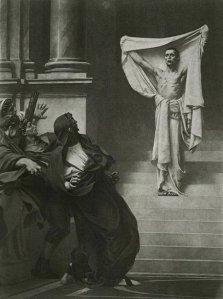Writing about St Joan of Arc recently I observed that she carries a particular importance for us as gay men, lesbians and transsexuals in the church, as her martyrdom at the hands of church authorities can be seen as a powerful metaphor for the persecution we receive from parts of the church, just for being honest about ourselves, for refusing to renounce our God-given identity. I've been thinking further along these lines, and in fact all the Christian martyrs can similarly seen as role models - although the others were not typically executed by the church itself. One martyr in particular has been closely identified as a gay (male) icon - St Sebastian.
This is strictly speaking inappropriate, because there is not anything about Sebastian or his martyrdom that is particularly gay . The main reason quite frankly, that he has acquired this cult status is that painters for centuries have made striking images of his martyrdom, featuring half naked, desirable young men pierced with arrows: soft porn masquerading as inspirational religious art. ( The Independent newspaper has an excellent analysis, still available on-line, on just how this association developed through the art works.) Now, I have no problem with gay men enjoying pictures of St Sebastian, but have had some trouble seeing him as a specifically gay saint. However, I have come across one particular painting, quite different from the original, which immediately put me in mind of a concept I have written about before as a possible model for us in negotiating a proper relationship with the church. Here's the picture:
Gustave Rodolphe Boulanger, 1877
This is how I wrote about his death earlier this year:
Ordered to be executed, he was tied naked to a column and shot with arrows. Widely represented in art, it was not this, however, that killed him. He was left for dead, but was nursed back to life. After recovering, he intercepted the Emperor and denounced him for his cruelty to Christians. Enraged, the Emperor once again ordered his execution. This time, he was beaten to death, on 20th January 288. How many others have achieved martyrdom twice in one lifetime?
The image shows Sebastian pierced by arrows but "not dead yet", confronting the Emperor Maximilian after the first attempted execution.
So, what's the connection? Recall Michael B Kelly's concept of the walk back from Emmaus , the idea that as lesbigaytrans people in the Catholic church, we have a need, even an obligation, to walk away from the church - and hen to return , to confront the institutional leaders of the church with the reality of the risen Lord, and of his real message to the world. When I saw this image, I suddenly saw it as representing all queer people confronting the emperors of the church with the evidence of their attempted martyrdom. In spite of all the efforts of the ecclesiastical mechanism, through the misrepresentation of Scripture, the characterization of us as "gravely "disordered, the active opposition in the political sphere to equal civic rights, and the failure to oppose criminalization, and hence the tacit support given to active bullying, violence and murder - not to mention actual execution by burning at the stake, in earlier years- we too, are not dead yet.
Following the example of Sebastian, the challenge facing us to do more than simply mope about our pain, satisfied with mere survival. We too, must return to the church, showing them with the evidence of our pain-then negotiate with them a process of reconciliation.
For a look at some of the extraordinary range of representations os Sebastian in art, just look at the results of a Google Image search, or go to "Iconography of Saint Sebastian (painting)", which has an immense collection of links to art images, usefully arranged chronologically and by artist. I particularly like some of the images by 20th century artists, which seemed to me to go beyond the soppy sentimentality to something real and relevant. This one is startling - Sebastian as a self-portrait by a female artist, Gael Erwin. And why not?



No comments:
Post a Comment